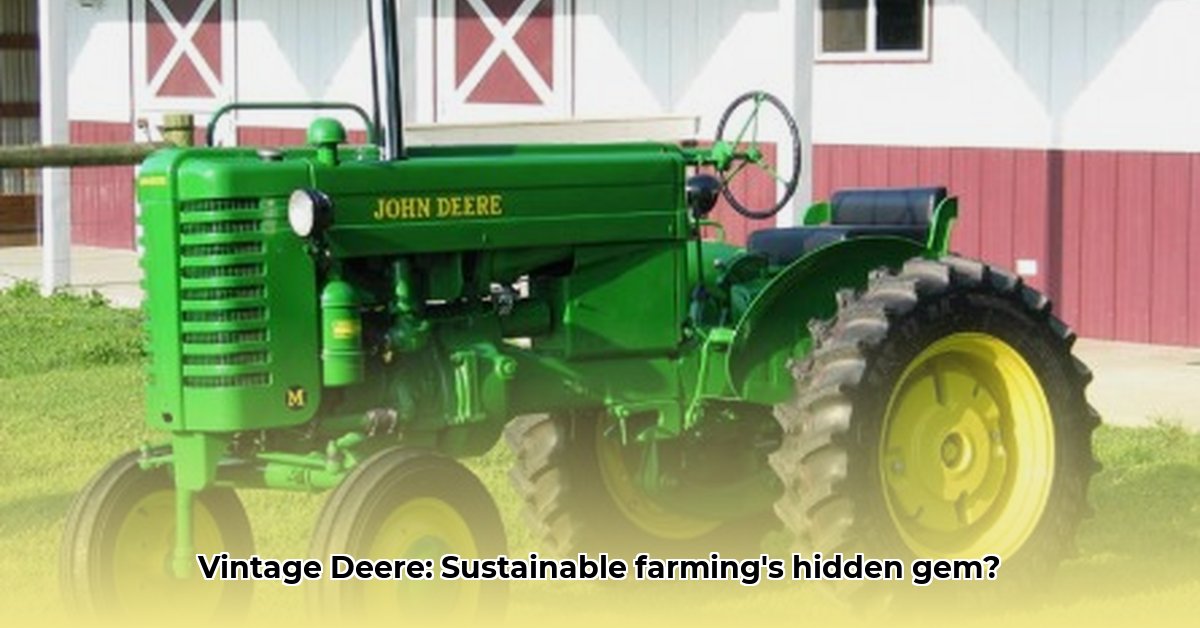
Old Model John Deere Tractors: A Legacy of Innovation and Sustainable Agriculture
The rhythmic chug of a vintage John Deere tractor, the smell of freshly turned earth, the image of a weathered farmer skillfully guiding a machine built decades ago—these evoke a bygone era of farming. But these aren't mere relics; they represent a fascinating chapter in agricultural evolution and a surprising resurgence in modern sustainable farming. This isn't just a history lesson; we'll delve into the mechanics, durability, and surprisingly relevant role these tractors play today. We'll explore fuel efficiency, collector value, restoration techniques, and their impact on sustainable agriculture. Sometimes, older truly is better. For more on the largest John Deere tractors ever built, check out this page.
Imagine Elias, a farmer from Iowa, inheriting his grandfather’s Model D in 1947. Before this workhorse, his days were long and arduous, relying on horses to plow his fields. The Model D transformed his life, allowing him to cultivate exponentially more acreage with significantly less physical strain. This exemplifies the revolutionary impact early John Deere tractors had on American agriculture. They weren't just machines; they symbolized progress and a new era of efficiency. Did this increased efficiency, however, come at an environmental cost? This question is vital in the context of modern sustainability.
John Deere's journey wasn't linear. Economic shifts, like the Great Depression, profoundly shaped its trajectory. Suddenly, durability and affordability became paramount, leading to the legendary Model D's enduring popularity. Its robust design allowed it to outlast many of its contemporaries, becoming a symbol of resilience. Later models, influenced by industrial designer Henry Dreyfuss, showcased the marriage of form and function, creating tractors that were both visually appealing and more efficient to operate. But how did these design changes influence their environmental footprint? A key consideration in today's sustainable farming practices.
Let's explore the technical aspects. The transition from gasoline to diesel engines marked a significant advancement, boosting horsepower and fuel efficiency. But did this increased power come with unforeseen environmental consequences? The fuel consumption of these older models, when compared to modern, highly efficient tractors, remains a subject of ongoing debate amongst agricultural experts. We need to analyze their total environmental effect—fuel usage, maintenance needs, and ultimate disposal—to fully grasp their role in modern, environmentally conscious agriculture.
Here's a glimpse into some notable models:
| Model | Year Introduced (approx.) | Engine Type | Horsepower (approx.) | Key Features |
|---|---|---|---|---|
| Waterloo Boy | Early 1900s | Gasoline | 12-15 | Simple, reliable, revolutionary for its time |
| Model D | 1923 | Gasoline | 20-30 | Iconic, incredibly durable, a true workhorse |
| Model A | 1927 | Gasoline | 20-30 | Enhanced design and versatility |
| Model B | 1935 | Gasoline | 20-30 | Streamlined design by Henry Dreyfuss, improved aesthetics |
(Note: Horsepower is approximate and can vary based on specific configurations.)
Beyond their agricultural significance, many older John Deere tractors are highly sought-after collectibles. Their craftsmanship, historical context, and inherent nostalgia contribute to their value. Restoring one is a challenging yet rewarding endeavor, combining mechanical expertise with historical detective work. It's a testament to their robust manufacture.
The legacy of vintage John Deere tractors extends far beyond mere nostalgia. They serve as a powerful reminder of the critical link between innovation and our connection to the land. They represent an era of close farmer-environment interaction. By studying both their successes and shortcomings, we uncover invaluable lessons for creating a more sustainable agricultural future. The ongoing research assessing the long-term ecological impacts of older farming technologies will significantly shape our understanding of sustainable practices. How can understanding the past inform a more environmentally conscious future?
How John Deere Tractors Impact Sustainable Farming Practices
Key Takeaways:
- Early models, while less fuel-efficient, significantly increased productivity, reducing the need for land expansion.
- Modern precision farming technologies found on later models decrease fuel and resource consumption.
- High initial investment costs and accessibility remain significant challenges for sustainable farming adoption.
A Legacy of Innovation: The John Deere Story
John Deere’s impact on farming is undeniable. The evolution from horse-drawn plows to today's advanced machinery is remarkable. How did these changes affect sustainable practices? Early models, despite their simpler technology, played a crucial role. Their robust construction meant longer lifespans, reducing the need for frequent replacements, minimizing waste—a key aspect of sustainable agriculture.
Efficiency and Environmental Considerations: The Early Years
Though less fuel-efficient than modern tractors, early models offered a substantial advantage over animal power. They enabled faster cultivation of larger areas, reducing the need to clear new land, thus minimizing deforestation and habitat destruction. While fuel consumption was higher, the overall efficiency gain was significant. This highlights how older models contributed, albeit differently, to sustainable farming practices.
The Evolution of Efficiency: Precision Farming and Beyond
Later John Deere models integrated advancements central to sustainable agriculture. GPS-guided systems and automated steering dramatically reduced fuel waste by minimizing overlaps during planting and spraying. This precision translates directly into environmental gains. Moreover, data management systems provide detailed insights into yields, soil health, and resource usage, empowering data-driven, resource-efficient decision-making.
Challenges and Considerations: Cost and Accessibility
A significant hurdle remains: the high cost of purchasing and maintaining these tractors and their associated technologies, particularly for smaller farms. Accessibility is a critical element for achieving truly sustainable agriculture. Affordable technology is essential; only affordable techniques can be broadly adopted.
Looking Ahead: Sustainable Practices in Farming
The future of sustainable farming relies on ongoing technological innovation. John Deere and others are pursuing more fuel-efficient engines, alternative fuels, and refined precision farming techniques. The focus is on balancing environmental responsibility with agricultural productivity. This ongoing development will be crucial in shaping the future of farming and its impact on the environment.
[1] https://www.tractortaishan.com/the-impact-of-john-deere-tractors-on-modern-agriculture/